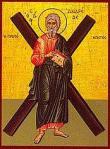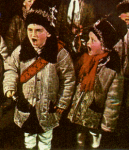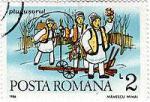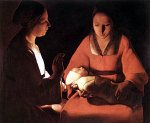Saint Andrew
 Romanians celebrate Saint Andrew as a patron saint on the 30 November. The night of Saint Andrew is destined to some pre-Christian customs for the protection of the people, animals and households. Also, the eve of this feast is considered to be the moment when the barrier between the real world and the yonder world rises. It is also a good moment to find out how fruitful the next year will be.
Romanians celebrate Saint Andrew as a patron saint on the 30 November. The night of Saint Andrew is destined to some pre-Christian customs for the protection of the people, animals and households. Also, the eve of this feast is considered to be the moment when the barrier between the real world and the yonder world rises. It is also a good moment to find out how fruitful the next year will be.
Saint Nicholas
 On the 6th of December the kids wait inpatient to find out what gifts Saint Nicholas put into their shoes. It may happen, if a child wasn’t good enough during the last year, that Saint Nicholas brigs a little rod to that kid.
On the 6th of December the kids wait inpatient to find out what gifts Saint Nicholas put into their shoes. It may happen, if a child wasn’t good enough during the last year, that Saint Nicholas brigs a little rod to that kid.
Christmas
 This feast brings to life a lot of other customs. In the first day of Christmas carol singers sing Christmas carols holding in their hands a carton handmade star. They go to each house of the village or to each apartment from the block singing carols receiving little gifts in change, or money. An other tradition is the decoration of the Christmas Three.
This feast brings to life a lot of other customs. In the first day of Christmas carol singers sing Christmas carols holding in their hands a carton handmade star. They go to each house of the village or to each apartment from the block singing carols receiving little gifts in change, or money. An other tradition is the decoration of the Christmas Three.
The Easter
 The Easter means for the Romanians both the resurrection of Christ and the renewal of their everyday life. Everyone dresses with their best clothes and goes to the midnight mess. Candles are lightened for each person during the mess for bringing the sacred light into their souls and houses. It is also said that these candles protect those who carry them back home from thunder, lightening and injury. The custom is to celebrate Easter wits Easter cake and red eggs.
The Easter means for the Romanians both the resurrection of Christ and the renewal of their everyday life. Everyone dresses with their best clothes and goes to the midnight mess. Candles are lightened for each person during the mess for bringing the sacred light into their souls and houses. It is also said that these candles protect those who carry them back home from thunder, lightening and injury. The custom is to celebrate Easter wits Easter cake and red eggs.
The New Year
 The celebrating of the New Year was also allowed during the communist regime because it didn’t have a religious connotation. The tradition says that no one should spend this night alone. On the 31st of December the villagers perform a traditional procession with a decorated plough wishing their neighbors “A Happy new year!”. On the 1st of January children throw wheat seeds over the neighbor’s lintel washing them prosperity.
The celebrating of the New Year was also allowed during the communist regime because it didn’t have a religious connotation. The tradition says that no one should spend this night alone. On the 31st of December the villagers perform a traditional procession with a decorated plough wishing their neighbors “A Happy new year!”. On the 1st of January children throw wheat seeds over the neighbor’s lintel washing them prosperity.


 The territory of Romania that we all know today was occupied in the year 200
The territory of Romania that we all know today was occupied in the year 200 before Christ by a tribe called “the Dacians” that belonged to the big Thracian family. Under the rule of
before Christ by a tribe called “the Dacians” that belonged to the big Thracian family. Under the rule of  In the 13th Century some little pre-state formations were created, and anticipated the birth of the Principals of Moldova, Tara Romaneasca and Transylvania. These three Principals had many battles with the Ottoman Empire. In an attempt to protect these Principals, and to create a strong state that clouds withstand the ottoman fury, ruler Mihai Viteazul united the three Principals into one state by the year 1600. This union was undone a year later, after Mihai Viteazul was killed by general Basta. At the end of the 17th Century, Hungary and Transylvania become part of the Hapsburg Empire, after they defeated the Turks. In 1718 an important part of Tara Romaneasca called Oltenia was incorporated in the Austrian Empire. A few years later the Austrian Empire also occupied the north-east of Moldova, called Bucovina, while Basarabia was occupied by Russia in 1812.
In the 13th Century some little pre-state formations were created, and anticipated the birth of the Principals of Moldova, Tara Romaneasca and Transylvania. These three Principals had many battles with the Ottoman Empire. In an attempt to protect these Principals, and to create a strong state that clouds withstand the ottoman fury, ruler Mihai Viteazul united the three Principals into one state by the year 1600. This union was undone a year later, after Mihai Viteazul was killed by general Basta. At the end of the 17th Century, Hungary and Transylvania become part of the Hapsburg Empire, after they defeated the Turks. In 1718 an important part of Tara Romaneasca called Oltenia was incorporated in the Austrian Empire. A few years later the Austrian Empire also occupied the north-east of Moldova, called Bucovina, while Basarabia was occupied by Russia in 1812.









